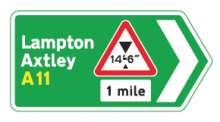This is a very old post. Sat nav devices are used now.
EDIT: Please use the blog search function to look for more recent posts on independent driving. This one was posted months ahead of the launch.
From 4th October 2010 a new stage will be included in the driving test, where the candidate is expected to drive to a specific destination as directed by the examiner. The new stage will only last about 10 minutes, so we’re not talking about finding your way from Lands End to John O’Groats or anything. It will be quite simple and over with quickly.

According to the DSA, the directions could be given in a number of ways (and the following is paraphrased from an official document).
In one case, the examiner might ask the candidate to drive to a specific place using traffic signs. Or, the examiner could give a series of verbal instructions to get to a specific location. Or it could be using a combination of both the above methods. The purpose of this exercise is to allow the candidate to demonstrate to the examiner how they will drive when they are out on their own – which is exactly what they will have to do when they have passed their test and no one is there to prompt them.
The DSA is currently putting together appropriate test routes for this part of the driving test. I can imagine that this isn’t as easy as it sounds, because they aren’t going to produce routes akin to Hampton Court Maze or choose ones where there are missing road traffic signs.

When it comes to this part of the driving test the examiner will have diagrams like simplified route maps to support the verbal instructions they give to candidates. These diagrams will be similar to the two shown here – though the DSA points out the final design isn’t yet agreed.
Much is being made of this change by the usual crowd of agitators.
It is actually very simple, although to listen to some people you’d think it was advanced calculus or something. The examiner will merely ask the candidate to drive from the current location (let’s say the road outside the Colwick Test Centre in Nottingham) to (let’s say) West Bridgford, using the road signs (and before anyone says anything, I don’t know if West Bridgford is signposted from that location without looking – but it doesn’t matter: it’s just an example). It’s a journey of about 3½ miles, and one which is covered by existing test routes. It involves two roundabouts and some traffic lights, and most candidates will have done the route plenty of times during their lessons anyway. The examiner may show a simplified road map like the ones here of the route, and the candidate can refer to it as many times as they like (safely, of course).
Personally, I think this is a great idea. I also believe that if someone cannot complete what is essentially an extremely simple exercise then they have no right to be on the road, as they are a danger to themselves and everyone else. I believe this applies to anyone who drives on the roads. And that means anyone.

I should point out that I have always taught my pupils to drive properly, not just to pass the test. I was out on such a lesson this afternoon, and I took my pupil (who is close to test standard) on a long drive using roads she’s not been on before.
I asked her to navigate using road signs – first of all to Mansfield via one route, then back to Nottingham via another. She immediately interrupted me and said that she couldn’t possibly look at the signs and drive at the same time!
After we got round that little situation, it did become clear that some signs just didn’t make sense to her at all – the ones on junctions being a particular problem.
She understands them now, but if all she had ever done is drive round and round near the test centre we would never have picked up the problem. And when she passed her test, she’d go straight out on her own without knowing how to drive on anything other than memorised routes. She is no different to most of my other pupils.
Anyone who is worried about this change shouldn’t be. I’ve seen websites (and blogs) where ADIs are advising people to do their tests quickly to avoid the change – this is appalling and alarmist behaviour, and rushing people to test who may not be ready also raises questions about the professionalism of these people.
The bottom line is that you will have to drive like this once you’ve passed your test, so learn how to do it properly now! You couldn’t drive a car at all before you started taking lessons, so a little bit of navigating won’t hurt you. In any case, if your mates arrange to meet you somewhere you’d probably have no trouble finding it on your bike – it’s not much different in a car.
But one last thing to remember: it is a driving test, and you can fail it. If you can’t navigate using the simple method proposed then there is a good chance you will fail the test.
EDIT 1/1/2012: There is an updated article here – you don’t need actual DSA diagrams to teach independent driving to pupils!